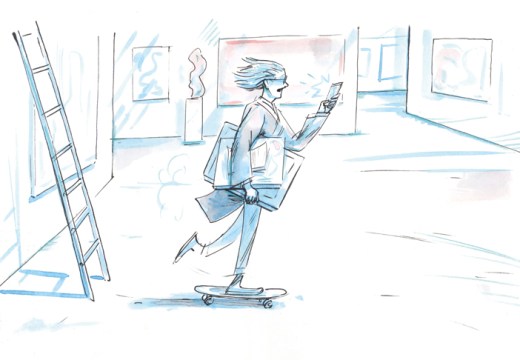It is impossible to avoid the society-wide nudge to study STEM subjects. As the cost of higher education has risen, students have compensated by prioritising areas of study that seem to lead to jobs in more lucrative industries, like tech and finance. A recent article in the New Yorker argued that this has led to an exodus from the humanities. Over the past decade, humanities enrolment has declined by 17 per cent in the United States, and four-fifths of OECD countries have experienced falling humanities enrolments.
Yet students of fine art seem to be unfazed. In fact, the number of students studying fine art has increased over the same period of the humanities’ decline. The growth has been patchy – there was a decline in enrolment immediately after the financial crisis of 2008 and many small art schools have closed or consolidated along the way – but it is growth nonetheless.
There is a sense in which this trend is not at all surprising – no one studies art for the money. So of course societal pressure to pursue job security won’t convince art students to switch paths.
Some art students don’t have to worry about money because they already have it. I’ve spoken to students from Parsons School of Design, for instance, who say they would never have chosen this path if they couldn’t fall back on their parents for financial support.
Still, there are many students who lack a robust safety net and choose to study fine art anyway, claiming to value creative freedom more than financial security. Ella Hepner, a recent graduate from Carnegie Mellon’s dual degree programme in art and humanities, says that only people in the United States raise an eyebrow when she says she wants to be an artist, asking, ‘How are you going to make money? In Europe or South America, people say wow, that’s amazing – you’re going to live an amazing life.’ When asked about whether she worries about her financial future, one student at the Fashion Institute of Technology (FIT) says, ‘Money is imaginary. You give it power.’ As long as she can feed herself, she says, she’ll be happy.
Such a disposition might be necessary for students who choose to study fine art. At least in the United States, 12.1 per cent of recent fine arts graduates were unemployed in 2021, which is the highest unemployment rate of any college major. It is even higher than the unemployment rate of high-school dropouts, which hovered at around five per cent over the past year. At the same time, the economist Bruno S. Frey, who studies happiness, says ‘artists generally are happier than the rest of the population’ because of the creative autonomy that comes with being an artist.
Studying fine art is a different from other kinds of college education. While a student who majors in engineering can reasonably expect to become an engineer, Sreshta Rit Premnath, a professor of fine arts at Parsons, says, ‘Most undergraduate students who graduate with a degree in fine art are not going to make a living selling their artwork – it’s just not happening. That doesn’t mean the programmes are a failure.’ Professor Sara Rafferty of the Pratt Institute in New York says that the benefits of an arts degree operate as a sort of ‘slow-release’. What students learn makes them better citizens and creative thinkers over the course of their lives, sometimes many years after graduation. For Susanna Coffey, a professor of fine art at Columbia University, studying art lets students exercise control in a world that is increasingly dominated by images.
These amorphous benefits can be a hard sell to parents who pay upwards of $200,000 for a four-year degree. Students are also starting to scrutinise what they get out of this transaction. Professor Premnath says that as the cost of education has gone up, many students are begging their professors for advice on how to translate particular lessons or classes into marketable skills. He adds, ‘Students never used to ask that question – there was just an understanding that a fine arts degree is not focused on the job market.’
However, that doesn’t mean these students ever really considered studying anything else. Many art students say this degree was their only viable option. Jamile, an art student at FIT, says that she started in a business programme at Lehman College, but she dropped out because she hated her classes and was falling behind. She later transferred to FIT to study fine art. Even now, she’s considering dropping out again, but she says she doesn’t think there’s anything else she would want to or could do. Many students say, and professors concur, that art is the only thing they’re good at.
Even students who do have the ability to study other subjects can still choose art because of an overwhelming passion that trumps everything else. Before they enrol in fine arts programmes, they need to convince their parents and everyone around them that it is a risk worth taking. ‘My hand was forced,’ says Bem Kanne, who transferred to Parsons from a business programme at Fordham University. ‘I suppose financial independence isn’t really my first thought when studying art. It’s just what I wanted to do.’
Academic training in fine art can teach students how to critique the world in creative ways, which involves a deliberate distancing from the rest of society. This can come at a cost when it means artists choose not to pursue the same paths everyone else takes that provide more financial security. But, as Emily Cheng, a retired professor from New York’s School of Visual Arts, says, ‘Art is one of the few places where you can be independent in a socially acceptable way.’
Unlimited access from just $16 every 3 months
Subscribe to get unlimited and exclusive access to the top art stories, interviews and exhibition reviews.














![Masterpiece [Re]discovery 2022. Photo: Ben Fisher Photography, courtesy of Masterpiece London](http://www.apollo-magazine.com/wp-content/uploads/2022/07/MPL2022_4263.jpg)
It’s time for the government of London to return to its rightful home